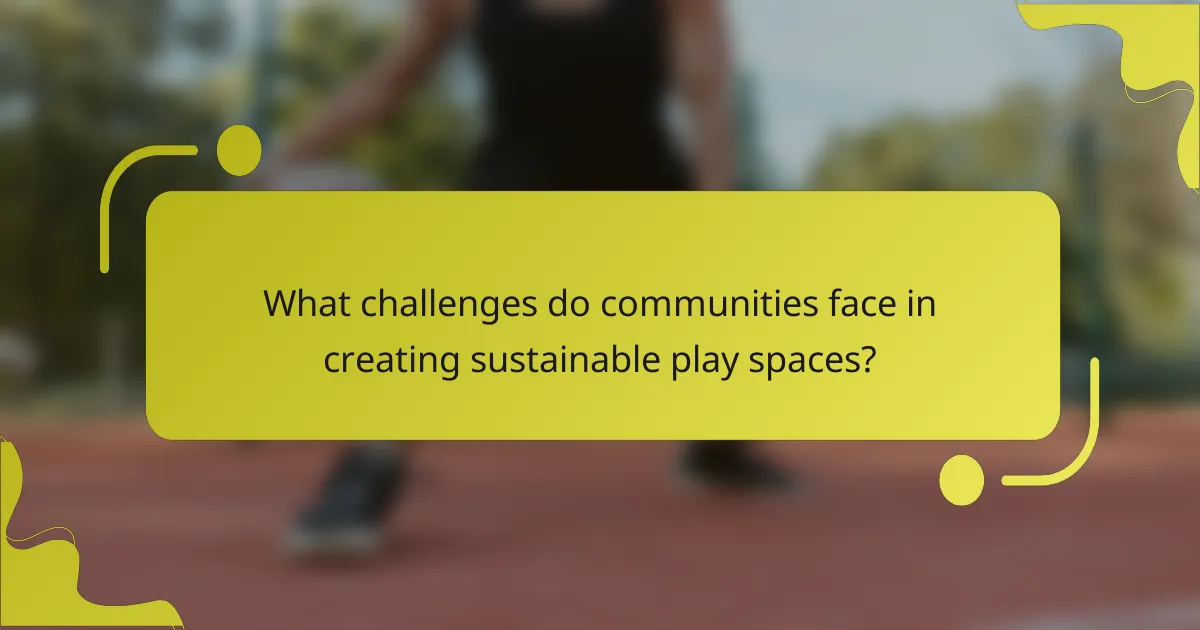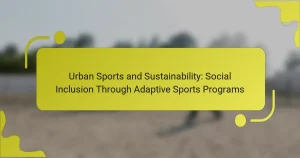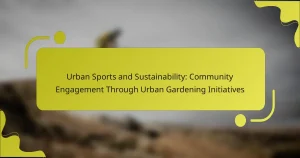Community-led initiatives enhance urban play spaces by fostering local engagement and promoting sustainability. These initiatives create inclusive environments that reflect community needs, integrate green features, and encourage social interactions. They face challenges such as funding and land availability while prioritising eco-friendly design and cultural influences. Metrics like participation rates and environmental impact help evaluate their effectiveness and long-term viability.

How do community-led initiatives enhance urban play spaces?
Community-led initiatives significantly enhance urban play spaces by fostering local engagement and promoting sustainable practices. These initiatives create inclusive environments that reflect community needs and preferences.
Incorporating local input leads to play spaces that are well-utilised and maintained. For instance, community members often volunteer for maintenance, ensuring longevity. Additionally, these spaces can integrate green features, such as native plants, which support biodiversity and improve air quality.
Such initiatives also encourage social interactions, strengthening community ties. Events organised in these spaces can bring diverse groups together, fostering a sense of belonging. As a result, urban play spaces become vibrant hubs of activity, enhancing overall urban livability.
Moreover, community-led projects can attract funding and resources, amplifying their impact. Collaborations with local businesses and organisations often result in enhanced facilities and programming, providing more opportunities for play and recreation.
What are the key benefits of urban sports in community development?
Urban sports significantly enhance community development by fostering social cohesion, promoting health, and revitalising public spaces. These activities encourage community engagement and inclusivity, leading to stronger neighbourhood ties.
Urban sports initiatives often involve local participation, which empowers residents to take ownership of their environments. This involvement can result in improved mental health and physical well-being, as active participation promotes fitness and reduces stress levels.
Moreover, urban sports can transform underutilised areas into vibrant play spaces, enhancing the aesthetic appeal of neighbourhoods. By integrating nature and recreational facilities, these initiatives contribute to environmental sustainability and urban resilience.
Overall, urban sports serve as a catalyst for positive change, driving community-led efforts that create healthier, more connected, and sustainable urban environments.
Which roles do local organisations play in promoting urban sports?
Local organisations play a crucial role in promoting urban sports by fostering community engagement and creating inclusive play spaces. They often lead initiatives that enhance accessibility and sustainability in urban environments. These organisations facilitate events, provide resources, and collaborate with local governments to develop facilities that support diverse sports activities. By prioritising community needs, they help cultivate a culture of health and well-being through urban sports.
How can urban sports contribute to social cohesion?
Urban sports foster social cohesion by creating inclusive environments that encourage community interaction. These activities promote teamwork and collaboration, bridging gaps between diverse groups. Community-led initiatives enhance urban play spaces, facilitating shared experiences that strengthen local bonds. Furthermore, participation in urban sports can lead to increased civic pride and engagement, as residents take ownership of their recreational spaces.

What challenges do communities face in creating sustainable play spaces?
Communities face several challenges in creating sustainable play spaces, including funding, land availability, and community engagement. Limited financial resources hinder the development and maintenance of these areas. Moreover, securing suitable land in urban settings often proves difficult due to competing interests. Engaging the community effectively is crucial; without local input, play spaces may not meet the needs of residents. Additionally, environmental considerations such as incorporating sustainable materials can complicate design efforts. These factors collectively impact the success of community-led initiatives for urban play spaces.
How does funding impact urban sports initiatives?
Funding significantly enhances urban sports initiatives by providing essential resources for development and sustainability. Financial support enables the creation and maintenance of community-led play spaces, fostering engagement and participation. It allows for the procurement of equipment, facilities, and training programmes, which are crucial for successful urban sports projects. Additionally, funding can facilitate partnerships with local organisations, amplifying outreach and impact. Ultimately, adequate funding is vital for the longevity and effectiveness of urban sports initiatives, ensuring they meet community needs and promote active lifestyles.
What are the common barriers to participation in urban sports?
Common barriers to participation in urban sports include lack of access to safe spaces, limited funding for facilities, and community engagement challenges. Additionally, social and cultural factors may discourage involvement, while inadequate transportation options can hinder accessibility. A unique attribute of urban sports is their reliance on community-led initiatives to overcome these obstacles, fostering inclusivity and sustainability.

Which innovative practices are emerging in urban sports sustainability?
Emerging practices in urban sports sustainability include community-led initiatives that prioritise eco-friendly design and local participation. These initiatives enhance urban play spaces while promoting environmental awareness. For example, urban parks now incorporate recycled materials and native plants, reducing maintenance costs and water usage. Additionally, community engagement fosters a sense of ownership, ensuring the longevity of these spaces. Collaborative events, such as clean-up days and workshops, further strengthen community ties and sustainability goals.
How are cities integrating green spaces into urban play areas?
Cities are increasingly integrating green spaces into urban play areas to enhance community well-being and environmental sustainability. Initiatives include transforming vacant lots into parks, creating rooftop gardens, and incorporating native plants in playground designs. These green spaces provide multiple benefits, such as improved air quality and increased biodiversity. Community-led projects often emphasise collaboration, ensuring local needs and preferences shape these developments. As a result, urban play areas become multifunctional spaces that support physical activity, social interaction, and ecological health.
What role does technology play in enhancing urban sports experiences?
Technology significantly enhances urban sports experiences by facilitating community engagement and improving accessibility. Smart platforms enable real-time updates on local events and facilities, fostering participation. Wearable technology tracks performance metrics, motivating athletes. Virtual reality offers immersive training environments, while mobile apps connect users to local sports initiatives, promoting sustainability in urban play spaces. These innovations support community-led efforts, making urban sports more inclusive and dynamic.

How do different cultures influence urban sports participation?
Different cultures significantly influence urban sports participation through community values, accessibility, and local traditions. Cultural norms shape preferences for specific sports, impacting participation rates. For instance, in some cultures, skateboarding may be more popular due to its association with youth and rebellion, while others may favour traditional sports like basketball or football.
Community-led initiatives play a crucial role in creating inclusive urban play spaces. These initiatives often reflect the cultural identity of the community, ensuring that the spaces cater to local preferences. Moreover, cultural attitudes toward physical activity can either encourage or deter participation in urban sports.
Collaboration among diverse cultural groups fosters innovation in urban sports. This diversity leads to unique event styles, competitions, and training programmes that attract broader participation. As a result, urban sports become a platform for cultural exchange and community bonding.
Sustainability is another key aspect influenced by culture. Communities with strong environmental values tend to promote eco-friendly practices in urban sports, such as using recycled materials for play spaces. This cultural emphasis on sustainability enhances the long-term viability of urban sports initiatives.
What unique urban sports initiatives are being developed in various regions?
Various regions are developing unique urban sports initiatives focused on sustainability and community engagement. Examples include the creation of multifunctional parks that incorporate skateboarding, climbing, and cycling areas. Cities like Barcelona and Melbourne emphasise eco-friendly materials and designs in their urban play spaces. Initiatives often involve local residents in the planning process, ensuring the spaces meet community needs. Some projects integrate green technologies, such as solar-powered lighting, enhancing sustainability while promoting active lifestyles.
How do cultural events shape community engagement in urban play?
Cultural events significantly enhance community engagement in urban play by fostering social connections and promoting inclusivity. These events create platforms for diverse groups to participate in sports and recreational activities, ultimately strengthening community bonds. For instance, festivals and tournaments encourage local involvement and showcase urban play spaces, increasing their utilisation. Moreover, they can drive sustainability initiatives by raising awareness about environmental practices within the community. Engaging with cultural events allows residents to express their identities, contributing to a vibrant urban culture that supports sustainable development.

What metrics are used to evaluate the success of urban sports initiatives?
Urban sports initiatives are evaluated using metrics such as participation rates, community engagement levels, and environmental impact. These metrics provide insights into the effectiveness and sustainability of urban play spaces.
| Metric | Description | Value |
|————————|————————————————|————————————-|
| Participation Rates | Number of individuals engaged in activities | Growth percentage year-over-year |
| Community Engagement | Involvement in planning and feedback sessions | Number of community meetings held |
| Environmental Impact | Assessment of ecological benefits | Reduction in urban heat by X% |
| Safety Incidents | Tracking accidents or injuries | Number of reported incidents |
| Economic Benefits | Local business revenue generated | Increase in sales from local shops |
| Social Cohesion | Improvement in community relationships | Survey results on community ties |
How can communities measure the impact of urban sports on health and well-being?
Communities can measure the impact of urban sports on health and well-being through surveys, participation metrics, and health data analysis. These methods assess both physical activity levels and mental health improvements. For example, tracking participation rates in urban sports programmes can highlight increased community engagement. Additionally, collecting health data pre- and post-participation offers insight into changes in physical fitness and mental well-being. Engaging local health organisations can further validate these findings and provide a comprehensive view of urban sports’ benefits.
What indicators reflect the sustainability of urban play spaces?
Indicators reflecting the sustainability of urban play spaces include community engagement, environmental impact, accessibility, and maintenance practices. Community involvement ensures spaces meet local needs and foster social cohesion. Assessing environmental impact involves evaluating green materials and biodiversity. Accessibility considers how easily all demographics can use the space. Regular maintenance practices are essential for long-term usability and safety.

What are the future trends in urban sports and sustainability?
Urban sports are increasingly integrating sustainability through community-led initiatives that promote inclusive play spaces. These trends focus on eco-friendly materials, urban greening, and social engagement.
One notable trend is the use of recycled materials for constructing sports facilities. This approach reduces waste and lowers carbon footprints. Community involvement ensures that these spaces reflect local needs and foster a sense of ownership.
Another trend is the incorporation of nature into urban sports environments. Green spaces enhance air quality and provide recreational areas, which can lead to healthier lifestyles.
Finally, urban sports initiatives are prioritising accessibility. Designing inclusive spaces encourages participation from diverse community members, promoting social cohesion and environmental awareness.
How can communities prepare for the evolving landscape of urban play?
Communities can prepare for the evolving landscape of urban play by fostering inclusive, adaptable spaces. These spaces should prioritise sustainability and community engagement.
First, assess local needs to identify suitable locations for urban play. Involve residents in the design process to ensure the spaces reflect their preferences.
Second, integrate sustainable materials and practices in the construction and maintenance of play areas. For instance, using recycled materials can reduce environmental impact while promoting community pride.
Third, establish partnerships with local organisations to facilitate programming and events. This collaboration can enhance the vibrancy of urban play spaces and encourage diverse participation.
Lastly, promote education around the benefits of urban sports and play. By raising awareness of the physical and mental health benefits, communities can inspire greater involvement in these initiatives.
What strategies can enhance community involvement in urban sports?
Community involvement in urban sports can be enhanced through targeted strategies that foster engagement. Initiatives such as organising local events, promoting volunteer opportunities, and creating partnerships with schools can significantly increase participation.
Additionally, providing accessible facilities and resources encourages diverse community members to engage in urban sports. Outreach programmes that involve local leaders can help tailor activities to community interests.
Supporting grassroots movements and encouraging feedback ensures that community voices shape urban play spaces. These approaches not only build a sense of ownership but also promote sustainability in urban sports initiatives.
What best practices should communities adopt for sustainable urban play spaces?
Communities should adopt inclusive design, sustainable materials, and active engagement to create effective urban play spaces. Inclusive design ensures accessibility for all ages and abilities. Using sustainable materials reduces environmental impact and promotes longevity. Active engagement encourages community involvement, fostering a sense of ownership and responsibility. These practices enhance social interaction and support environmental sustainability in urban areas.




